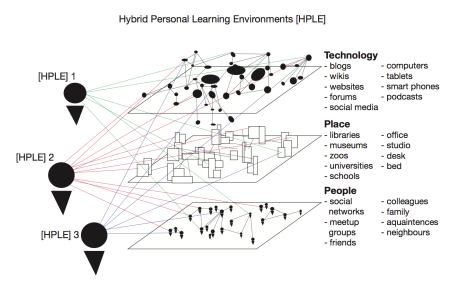Aim: Enhancing Informal Learning by Morphing Digital and Physical Spaces
Learning is situated in and facilitated by different environments. Formal learning environments such as schools or universities are highly institutionalised and follow a strict curriculum. Non-formal learning environments are based on voluntary participation outside the formal education system, but are still organised and coordinated by a central institution with a fixed curriculum, such as schools providing cooking classes, driving lessons, and language lessons. However, not all learning occurs in the classroom. Informal learning environments are often places of physical, emotional, and social comfort that provide stimuli to the senses outside of the typical educational setting. In contrast to formal and non-formal learning, informal learning is learner-centric, driven by the learner’s personal needs, interests, and motivations. Most literature on informal learning environments are concerned with informal learning either as a phenomenon that is situated in the physical space, or online (see figure below).
For this study, I joined forces with my architect colleague Glenda Caldwell and Marcus Foth to investigate hybrid design solutions for informal learning environments, i.e. design solutions that utilise digital as well as physical means to shape an informal learning environment. We constructed the term “Hybrid Personal Learning Environments” (HPLE) to refer to this evolving design space:
Approach: Focus Groups on Perceived Learning Places, Activities and People Networks
The point of departure for our study was to ask what such Hybrid Personal Learning Environments should look like? What content and information should they provide? And, how should they be represented? In order to shed light on these questions, we employed a participatory design research method that asks participants to reflect on places, activities and people networks that facilitate their personal learning.
Findings: People’s Ecology of Hybrid Personal Learning Environments
The results illustrate how informal learning – learning outside the formal education system – is facilitated by a personal selection of physical and socio-cultural environments, as well as online tools, platforms, and networks. The participants reveal personal places, activities, and social networks where they work (being productive, being creative), play (having fun, socialising, enjoying, being entertained) or learn (being inspired, acquiring or modifying knowledge and skills). The findings give rise to the assumption that informal learning is formed, shaped and maintained as learner-specific ecologies of hybrid personal learning environments (HPLEs). Informal learning is embodied in everyday activities and places that involve social interaction, productivity, and fun.
Implications for Libraries and Learning Environments
How are these insights relevant to the design of informal learning environments?
Public libraries strive to facilitate peer-to-peer learning, and embrace their user community as an information resource and asset for fellow library users. One way of doing this is to expose people’s hybrid personal learning environments and networks to each other. When these are exposed and communicated to each other, they can be enriched and built upon by others. Seeing objects or places that are relevant to an individual may attract others with similar interests and lead to a face-to-face interaction based on serendipitous discoveries of new topics and interests. Ambient media architecture provides tools to morph such social user information with the physical space of the library building.
We presented the results of this study at the Media Architecture Biennale 2012 in Aarhus, Denmark. Our paper discusses opportunities for ambient media architecture to augment public library spaces by reflecting representations of people’s HPLEs, hence provide affordances for divergent information behaviour, serendipitous encounters, and inspirations between fellow library users, which would otherwise remain invisible.
Publication
Caldwell, Glenda, Bilandzic, Mark, & Foth, Marcus (2012) Towards visualising people’s ecology of hybrid personal learning environments. In Brynskov, Martin (Ed.) Proceedings of the Media Architecture Biennale 2012, Association for Computing Machinery (ACM), Aarhus, Denmark, pp. 13-22. (download from eprints)
Abstract
Ambient media architecture can provide place-based collaborative learning experiences and pathways for social interactions that would not be otherwise possible. This paper is concerned with ways of enhancing peer-to-peer learning affordances in library spaces; how can the library facilitate the community of library users to learn from each other? We report on the findings of a study that employed a participatory design method where participants were asked to reflect and draw places, social networks, and activities that they use to work (be creative, productive), play (have fun, socialize, be entertained), and learn (acquire new information, knowledge, or skills). The results illustrate how informal learning – learning outside the formal education system – is facilitated by a personal selection of physical and socio-cultural environments, as well as online tools, platforms, and networks. This paper sheds light on participants’ individually curated ecologies of their work, play, and learning related networks and the hybrid (physical and digital) nature of these places. These insights reveal opportunities for ambient media architecture to increase awareness of and connections between people’s hybrid personal learning environments.



















Pingback: Gelatine – Designing for Digital Encounters in Coworking Spaces | kavasmlikon
Pingback: Personal Learning Environments – initial thoughts – ED F659 Multimedia Tools